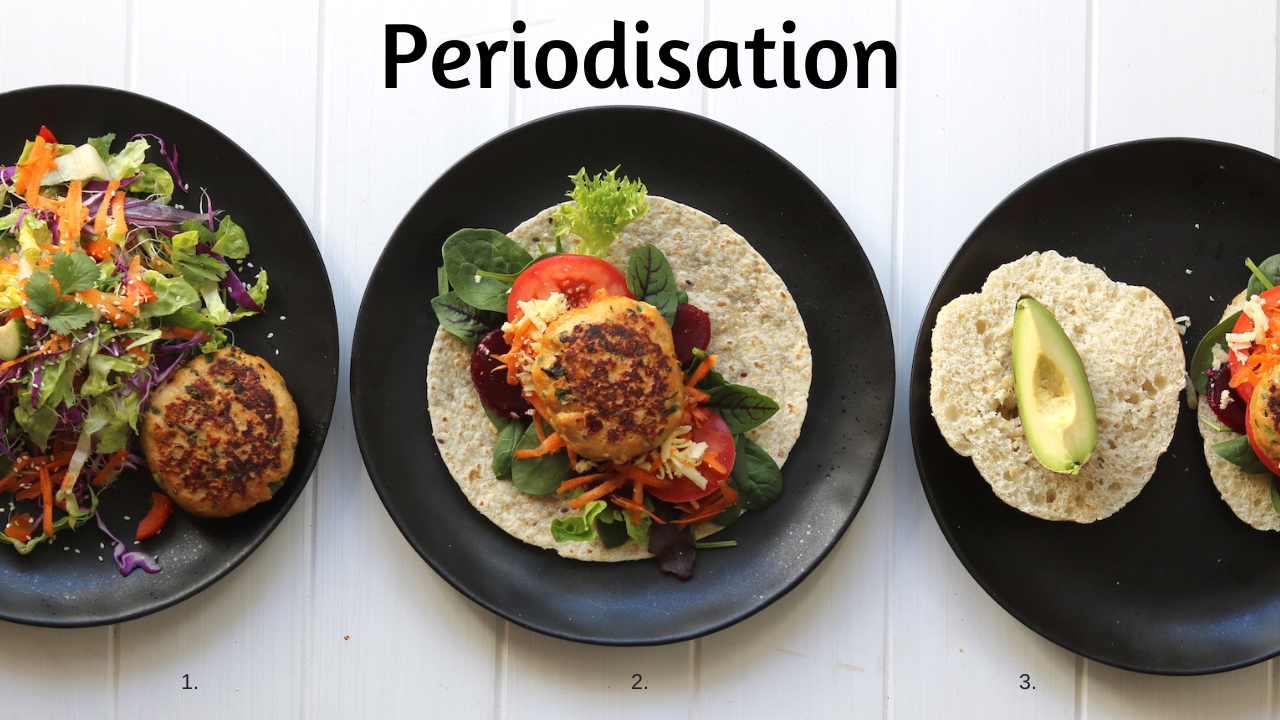Dietary Periodisation: What is it but how do you do it?..

We talk about periodising nutrition all the time, but WHAT the heck is it?
And HOW do you do it?
Nutrition Periodisation is the use of planned nutritional strategies aimed at maximising the results from specific training sessions to improve performance (1). It is just like having a training plan but for your nutrition, where your nutrition is planned around your training to get the most bang for your buck out of it.
Periodising nutrition primarily manipulates our glycogen stores, or our carbohydrate fuel tank.
There are a few ways dietary periodisation can be used:
1. Train low
This is where you train with low glycogen stores. For example, you train first thing in the morning on an empty stomach or you don’t quite top your glycogen stores back up between sessions. This allows your body to learn to run more efficiently on a lower fuel tank. For athletes that train twice or even three to four times a day, chances are they are probably running on lower glycogen stores for some of those sessions.
2. Sleep low
This is where you sleep with low glycogen stores. For example, you have a hard, glycogen-depleting session in the evening and don’t include adequate carbohydrate with dinner to fully refuel your glycogen fuel tank overnight. You’re going to sleep ‘low’. This allows the body to adapt overnight. It’s then important to fuel up before your session in the morning (especially for females) as this has implications on iron and calcium pathways.
3. Recover low
This is where you delay refuelling in that immediate post-exercise recovery window. Not refuelling immediately after training allows us to adapt to changes occurring as a result of training (2).
4. Train high
This is where you train on a full glycogen tank. This not only supports a quality training session, it also trains your gut to absorb carbohydrate efficiently and can maximise the amount of carbohydrate we can use for energy each hour (1).
By manipulating our carbohydrate availability around sessions, we can maximise our training response. Training with high carbohydrate availability, improves performance, especially for the high-intensity sessions where top-end speed is required (1). By training with low glycogen stores, we force our body to adapt, to utilise fat as a fuel, making this pathway more efficient and improving aerobic performance. However, when we are running on an empty carbohydrate tank, the quality of our training is compromised.
We train to get fitter, faster and more efficient. We spend hours and hours training, but if we haven’t got our nutrition sorted, it can be harder to reach our goals. Invest in some planning of your nutrition, periodised across your training week to get the most bang for your buck. The improved performance was observed after just 1 week of periodised nutrition in cyclists (3).
As Accredited Sports Dietitian’s, periodisation is our forte! We can help you work out which method to utilise, when across your training week as you can’t do them all at once. Nutrition periodisation is most effective when following a plan and choosing the most appropriate training sessions to pair it with based on your goals (2).
Now let’s talk about HOW to periodise your nutrition…
Here is an example of the same recipe, but adjusted for carbohydrate content depending on the goals of that meal.
Image 1 is our infamous Chicken burger patty (get the FREE recipe HERE) with our Asian Slaw and Soy Dressing.
Image 2 is our Chicken burger patty on a wholegrain wrap with salad
Image 3 is our Chicken burger patty on a large Turkish bread roll with salad
You’ll see that the protein portion of each meal remains the same. And the SIZE of the meal is also similar. Yet the carbohydrate content ranges from 20g up to 90g. This my friends is an example of HOW you periodise your nutrition. You’re welcome. 😊
Now we don’t want to give all of our secrets away so the detail stops there, sorry 🙂
Book in for a consultation if you want further help with periodising your nutrition.

References:
(1) Jeukendrup, A, E. Periodized Nutrition for Athletes. Sports Med. 2017; 47 (Suppl 1): S51-63.
(2) Marquet L, A et al. Enhanced Endurance Performance by Periodization of Carbohydrate Intake: “Sleep Low” Strategy. Medicine & Science in Sports & Exercise. 2016; Vol 48(4): 663-672.
(3) Marquet 2 et al. Periodization of Carbohydrate Intake: Short-Term Effect on Performance. Nutrients. 2016; 8(12): 755.
If you are looking for a Sports Dietitian and want to learn more about working with me, click on the image below to see what I offer for private, 1 on 1 consultation.
If you’re looking for a more cost-effective option, start with one of my online courses.
Tags: athleats, Brisbane Dietitian, Brisbane Sports Dietitian, dietary periodisation, dietitian, Dietitian Approved, Dietitian Approved Crew, Dietitian Brisbane, nutrition for performance, nutrition for triathlon, optimised nutrition, periodisation, periodised nutrition, personalised nutrition, Sports Dietitian Australia, Sports Dietitian Brisbane, sports nutrition, sports performance, triathlon nutrition




